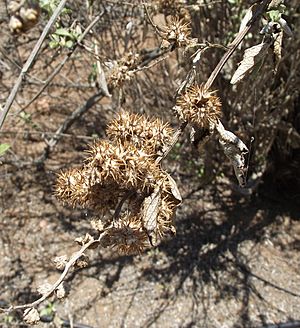San Diego bursage facts for kids
Quick facts for kids San Diego bursage |
|
|---|---|
 |
|
| Conservation status | |
| Scientific classification | |
| Genus: |
Ambrosia
|
| Species: |
chenopodiifolia
|
| Synonyms | |
|
|
Ambrosia chenopodiifolia is a type of ragweed plant. People often call it the San Diego bursage or San Diego bur ragweed. This plant naturally grows in parts of Mexico, specifically in the states of Baja California and Baja California Sur. It also grows in the United States, in Orange and San Diego Counties in California. You can often find it in a special plant area called the coastal sage scrub community.
What it Looks Like
Ambrosia chenopodiifolia is a shrub, which means it's a woody plant smaller than a tree. It has many branches and can grow quite tall, sometimes over 3 meters (about 10 feet).
Leaves and Stems
The leaves of this plant are shaped like ovals. They can be up to 3 centimeters (about 1 inch) long. These leaves are covered in soft, white hairs, which makes them look a bit fuzzy. Sometimes, the leaves have small cuts or lobes on their edges.
Flowers and Fruits
Like other ragweeds, this plant is monoecious. This means that each plant has both male and female flowers. The flowers grow in a group called an inflorescence. The female flowers are found below a bunch of male flowers.
When the plant produces fruit, the inflorescence becomes spiny. The fruit itself is a round, woolly bur. It's about half a centimeter long and covered in hooked spines. These spines help the bur stick to animals or clothes, which helps the plant spread its seeds.


